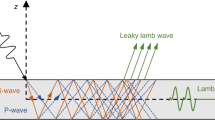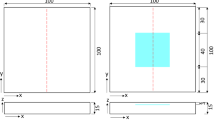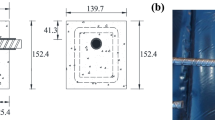Abstract
The hammering method used by inspectors is generally applied to inspection of looseness of bolted parts. This method entails active sensing through the input of an excitation signal produced by the inspectors, and has the advantage of practical experience acquired over many years. The sound (vibration) and sensation produced upon excitation by a hammer can be used as indices, but also leads to the disadvantage of unavoidable qualitative testing and human error. Laser remote sensing (LRS) uses the same diagnostic principle as the hammering test for remote, high-speed, and quantitative inspection. However, the accuracy of LRS must be improved and the required pulse energy must be reduced. Hence, we propose the sweep pulse excitation method, which realizes LRS with low pulse energy through the resonance oscillation caused by sweeping the laser irradiation frequency. A performance test on bolted joints was conducted with regard to bolt loosening diagnosis using two methods, namely, the conventional single-pulse excitation method and the sweep pulse excitation method. With the sweep pulse excitation method, the laser-induced vibration is produced only by absorbing the laser pulse energy which is caused by thermo-elastic waves and without using the elastic wave induced by the laser ablation. The experimental and calculation results reveal that, with the proposed method, the measurement accuracy improved by 104 times, while the required pulse energy decreased by 102 times. The adaptability of the low-pulse energy laser contributes toward the development of inspection systems because it achieves size and cost reduction, and inspection convenience.











Similar content being viewed by others
References
Hosoya, N., Hosokawa, T., Kajiwara, I., Hashimura, S., Huda, F.: Evaluation of the clamping force of bolted joints using local mode characteristics of a bolt head. J. Nondestruct. Eval. 37, 75 (2018). https://doi.org/10.1007/s10921-018-0528-7
Sah, S.M., Thomsen, J.J., Brons, M., Fidlin, A., Tcherniak, D.: Estimating bolt tightness using transverse natural frequencies. J. Sound. Vib. 431, 137–149 (2018). https://doi.org/10.1016/j.jsv.2018.05.040
Chen, R., Chen, S., Yang, L., Wang, J., Xu, X., Luo, T.: Looseness diagnosis method for connecting bolt of fan foundation based on sensitive mixed-domein features of excitation-response and manifold learning. Neurocomputing 219, 376–388 (2017). https://doi.org/10.1016/j.neucom.2016.09.041
Meyer, J.J., Adams, D.E.: Theoretical and experimental evidence for using impact modulation to assess bolted joints. Nonlinear Dyn. 81, 103–117 (2015). https://doi.org/10.1007/s11071-015-1976-6
Milanese, A., Marzocca, P., Nichols, J.M., Seaver, M., Trickey, S.T.: Modeling and detection of loosing using output-only broadband vibration data. Struct. Health Monit. 7, 309–320 (2018). https://doi.org/10.1177/1475921708090565
Devaux, D., Fabbro, R., Tollier, L., Bartnicki, E.: Generation of shock waves by laser-induced plasma in confined geometry. J. Appl. Phys. 74, 2268–2273 (1993). https://doi.org/10.1063/1.354710
Berthe, L., Fabbro, R., Peyre, P., Toiller, L., Bartnicki, E.: Shock waves from a water-confined laser-generated plasma. J. Appl. Phys. 82, 2826–2832 (1997). https://doi.org/10.1063/1.366113
Peyre, P., Fabbro, R., Merrien, P., Lieurade, H.P.: Laser shock processing of aluminum alloys. Application to high cycle fatigue behavior. Mate. Sci. Eng. A 210, 102–113 (1996). https://doi.org/10.2351/1.4745414
Hosoya, N., Kajiwara, I., Hosokawa, T.: Vibration testing based on impulse response excited by pulsed-laser ablation: measurement o frequency response function with detection-free input. J. Sound. Vib. 331, 1355–1365 (2012). https://doi.org/10.1016/j.jsv.2011.10.034
Hosoya, N., Kajiwara, I., Umenai, K., Maeda, S.: Dynamic characterizations of underwater structures using noncontact vibration tests based on nanosecond laser ablation in water: evaluation of passive vibration suppression with damping materials. J. Vib. Cont. 24, 3714–3725 (2018). https://doi.org/10.1177/1077546317710158
Mikami, K., Hasegawa, N., Kitamura, T., Okada, H., Kondo, S., Nishikino, M.: Characterization of laser-induced vibration on concrete surface toward high efficient laser remote sensing. Jpn. J. Appl. Phys. (2020). https://doi.org/10.35848/1347-4065/ab9849
Kurahashi, S., Mikami, K., Kitamura, T., Hasegawa, N., Okada, H., Kondo, S., Nishikino, M., Kawachi, T., Shimada, Y.: Demonstration of 25-Hz-inspection-speed laser remote sensing for internal concrete defects. J. Appl. Remote Sens. 12, 15009 (2018). https://doi.org/10.1117/1.JRS.12.015009
Mikami, K., Hasegawa, N., Okada, H., Kondo, S., Nishikino, M., Kawachi, T.: Flash-lamp-pumped 4 J, 50 Hz Nd:YAG nanosecond laser system for mobile and transportable equipment. Jpn. J. Appl. Phys. 56, 082701 (2017). https://doi.org/10.7567/JJAP.56.082701
Nakashima, D., Ishii, K., Matsumoto, M., Nakamura, M., Nagura, T.: A study on the use of the Osstell apparatus to evaluate pedicle screw stability: an in-vitro study using micro-CT. PLoS ONE 13, e0199362 (2018). https://doi.org/10.1371/journal.pone.0199362
Henys, P., Capek, L.: Impact force, polar gap and modal parameters predict acetabular cup fixation: a study on a composite bone. Annl. Biomed. Eng. 46, 590–604 (2018). https://doi.org/10.1007/s10439-018-1980-3
Henys, P., Capek, L., Fencl, J., Prochazka, E.: Evaluation of acetabular cup initial fixation by using resonance frequency principle. J. Eng. Med. 229, 3–8 (2015). https://doi.org/10.1177/0954411914561485
Kikuchi, S., Mikami, K., Nakashima, D., Kitamura, T., Hasegawa, N., Nishikino, M., Kanaji, A., Nakamura, M., Nagura, T.: Laser resonance frequency analysis: a novel measurement approach to evaluate acetabular cup stability during surgery. Sensors 19, 4876 (2019). https://doi.org/10.3390/s19224876
Kajiwara, I., Miyamoto, D., Hosoya, N., Nishidome, C.: Loose bolt detection by high frequency vibration measurement with non-contact laser excitation. J. Syst. Des. Dyn. 5, 1559–1571 (2011). https://doi.org/10.1299/jsdd.5.1559
Hosoya, N., Kajiwara, I., Inoue, T., Umenai, K.: Non-contact acoustic tests based on nanosecond laser ablation: Generation of a pulse sound source with a small amplitude. J. Sound. Vib. 333, 4254–4264 (2014). https://doi.org/10.1016/j.jsv.2014.04.050
Hosoya, N., Nagata, M., Kajikawa, I., Umino, R.: Nano-second laser-induced plasma shock wave in air for non-contact vibration tests. Exp. Mech. 56, 1305–1311 (2016). https://doi.org/10.1007/s11340-016-0167-9
Huda, F., Kajiwara, I., Hosoya, N., Kawamura, S.: Bolt loosening analysis and diagnosis by non-contact laser excitation vibration test. Mech. Systems Sig. Proc. 40, 589–604 (2013). https://doi.org/10.1016/j.ymssp.2013.05.023
Sparks, M., Loh, E., Jr.: Temperature dependence of absorptance in laser damage od metallic mirrors: I. Melting. J. Opt. Soc. Am. 69, 847–858 (1979). https://doi.org/10.1364/JOSA.69.000847
Amerini, F., Meo, M.: Structural health monitoring of bolted joints using linear and nonlinear acoustic/ultrasound methods. Struct. Health Monit. 10, 659–672 (2011). https://doi.org/10.1177/1475921710395810
Acknowledgements
This study was partially funded by Grant-in-aid for Scientific Research (C) and Young Scientists under Grant Nos. 19K04286 and 20K14684 from JSPS. Additionally, this study was supported by the 2020 Kindai University Research Enhancement Grant (SR07).
Author information
Authors and Affiliations
Corresponding author
Ethics declarations
Conflict of interests
The authors declare that they have no conflict of interests.
Additional information
Publisher's Note
Springer Nature remains neutral with regard to jurisdictional claims in published maps and institutional affiliations.
Rights and permissions
About this article
Cite this article
Mikami, K., Zhao, Y., Morita, M. et al. Highly Sensitive Low-Energy Laser Sensing Based on Sweep Pulse Excitation for Bolt Loosening Diagnosis. J Nondestruct Eval 40, 12 (2021). https://doi.org/10.1007/s10921-020-00746-6
Received:
Accepted:
Published:
DOI: https://doi.org/10.1007/s10921-020-00746-6




